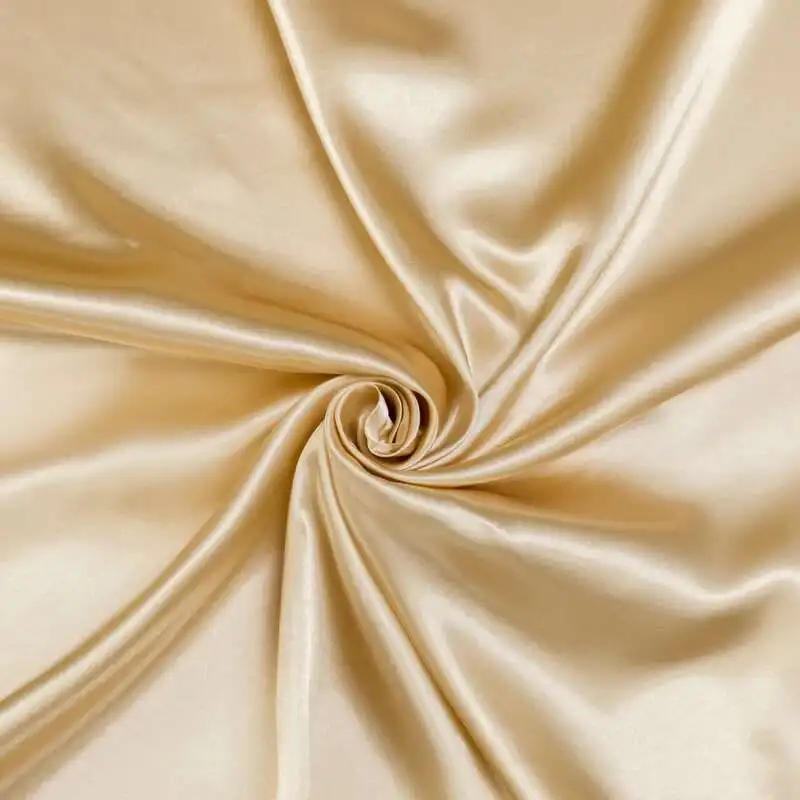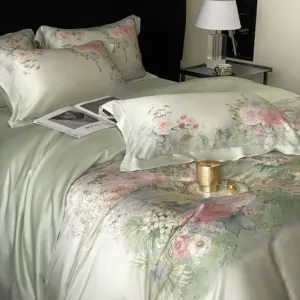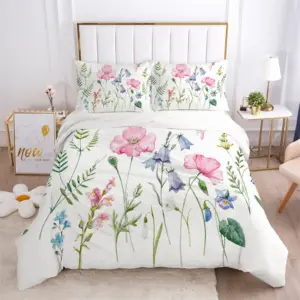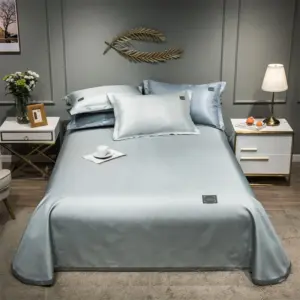Introduction to Hypoallergenic Fabrics
Living with sensitive skin can make the simple act of getting dressed or sliding into bed an uncomfortable experience. The fabric against your skin matters more than most people realize – especially if you have allergies, eczema, or skin sensitivities.
“Hypoallergenic” doesn’t mean completely allergen-free. Instead, it refers to materials that are less likely to cause allergic reactions compared to other fabrics. These special textiles have properties that make them gentler on reactive skin, including:
- Natural breathability that prevents moisture build-up
- Smooth fibers that minimize friction against skin
- Minimal chemical processing that reduces exposure to irritants
With skin sensitivities and textile allergies becoming increasingly common, finding truly skin-friendly fabrics has never been more important. Approximately 1 in 10 people experience some form of textile-related skin irritation, from mild itchiness to severe dermatitis.
In this guide, we’ll explore the best hypoallergenic fabric options available today, examining why certain materials excel at keeping sensitive skin comfortable while others may trigger reactions. The remarkable benefits of mulberry silk sheets make this luxurious fabric a standout choice for those with skin concerns, particularly those seeking mulberry silk sheets for sensitive skin to enhance their sleep experience.
Understanding What Makes a Fabric Truly Hypoallergenic
To identify truly hypoallergenic fabrics, we need to understand what causes skin reactions in the first place. Fabric irritants typically fall into three main categories:
- Chemical additives: Dyes, preservatives, wrinkle resistors, flame retardants
- Physical texture: Rough fibers, abrasive weaves, irritating structures
- Allergen retention: Ability to harbor dust mites, pollen, and other allergens
The most skin-friendly fabrics excel in several key areas:
- Natural vs. synthetic origin: Natural fibers generally contain fewer chemical irritants
- Fiber smoothness: Smoother fibers cause less mechanical irritation against skin
- Processing methods: Minimal chemical treatments preserve the fabric’s gentle nature
- Breathability: Air circulation prevents humidity that can irritate skin and promote allergen growth
- Resistance to allergens: Some fibers naturally repel dust mites, mold, and bacteria
It’s important to understand that “hypoallergenic” exists on a spectrum rather than being an absolute quality. Even the most skin-friendly fabrics may cause reactions in extremely sensitive individuals or those with specific allergies.
Certifications like OEKO-TEX Standard 100 and Global Organic Textile Standard (GOTS) provide valuable assurance that fabrics meet rigorous testing standards for harmful substances, making them useful guides when searching for truly hypoallergenic options.
The hypoallergenic features of silk sheets demonstrate why this natural protein fiber consistently ranks among the best options for sensitive skin.
Silk: The Ultimate Hypoallergenic Luxury
Among all natural fibers, silk—particularly mulberry silk—stands as the gold standard for hypoallergenic properties. This exquisite fabric offers unparalleled benefits for sensitive skin:
- Natural protein composition: Silk contains amino acids and proteins similar to those found in human skin, making it remarkably compatible with our bodies
- Ultrasmooth surface: At a microscopic level, silk fibers have an incredibly smooth surface that minimizes friction against skin
- Natural resistance to allergens: Silk naturally repels dust mites, mold, and fungus, reducing common triggers for allergic reactions
- Minimal chemical processing: High-quality silk requires fewer chemicals during production compared to most other fabrics
Mulberry silk specifically offers additional advantages for sensitive skin:
- Superior temperature regulation: Silk maintains an ideal microclimate against your skin, preventing the overheating that can trigger inflammation
- Exceptional moisture management: Silk can absorb up to 30% of its weight in moisture without feeling damp, keeping skin dry and comfortable
- Natural antimicrobial properties: Silk contains natural compounds that inhibit bacterial growth, reducing skin infections
- Optimal fiber quality: Premium mulberry silk with higher momme weights (19-25) provides the perfect balance of durability and softness
While silk requires gentle care (typically hand washing or delicate machine cycles), its longevity makes it a worthwhile investment. Many dermatologists recommend silk pillowcases and bedding for patients with sensitive skin, eczema, and even acne, as the smooth surface reduces friction that can aggravate these conditions.
The unique properties that make mulberry silk special explain why it consistently ranks as the most hypoallergenic natural fiber. For those seeking the ultimate in skin-friendly bedding, exploring quality mulberry silk sheets can be a transformative experience for sensitive skin.
Organic Cotton: The Versatile Hypoallergenic Staple
Organic cotton stands as a remarkably skin-friendly alternative to silk, offering excellent hypoallergenic properties at a more accessible price point. The distinction between conventional and organic cotton is crucial for sensitive individuals:
- Conventional cotton is typically grown using heavy pesticides and processed with harsh chemicals that can remain in the final fabric
- Organic cotton is cultivated without synthetic pesticides and processed using gentler methods, dramatically reducing potential irritants
The hypoallergenic properties of properly-certified organic cotton include:
- Pure cellulose fibers: 100% natural plant-based fibers free from synthetic additives
- Superior breathability: Allows continuous airflow that prevents moisture accumulation against skin
- Excellent absorbency: Quickly wicks away sweat and moisture, keeping skin dry and comfortable
- Soft texture: Particularly in long-staple varieties, organic cotton provides mechanical comfort against sensitive skin
For truly hypoallergenic cotton, look for respected certifications:
– Global Organic Textile Standard (GOTS): Ensures organic growing practices and restricts harmful chemicals
– OEKO-TEX Standard 100: Certifies the final product is free from harmful levels of over 100 substances
Organic cotton’s versatility makes it suitable for virtually every textile application: clothing (especially undergarments), bedding, towels, and baby products. To maintain its hypoallergenic properties, wash organic cotton in fragrance-free, dye-free detergents and avoid fabric softeners, which can leave irritating residues.
Understanding the full spectrum of natural hypoallergenic fabrics helps consumers make informed choices beyond cotton and silk.
Lyocell (Tencel™) and Modal: Advanced Semi-Synthetic Options
Bridging the gap between natural and synthetic fabrics are semi-synthetic cellulose fibers like Lyocell (often sold under the brand name Tencel™) and Modal. These innovative materials start with wood pulp (typically from eucalyptus or beech trees) that undergoes advanced processing to create remarkably skin-friendly fabrics.
These materials excel as hypoallergenic options because of their:
- Exceptionally smooth fiber surface: Even smoother than cotton, reducing friction against sensitive skin
- Superior moisture management: These fabrics can absorb up to 50% more moisture than cotton while feeling dry to the touch
- Natural antibacterial properties: The fiber structure inhibits bacterial growth, reducing odors and potential skin irritation
- Closed-loop manufacturing: Most notably with Tencel™, the production process recycles 99% of solvents, minimizing harmful chemical residue
When comparing the two:
– Tencel™ (primarily from eucalyptus) offers slightly better moisture management and cooling properties
– Modal (typically from beech trees) provides exceptional softness and drape, making it ideal for body-hugging garments
These fabrics perform exceptionally well in applications like bedding, intimate apparel, and activewear where moisture management is crucial. Their sustainability credentials—requiring less water and land than cotton while using renewable wood sources—make them excellent choices for environmentally-conscious consumers with sensitive skin.
For those seeking plant-based alternatives to silk, eucalyptus silk sheets provide many similar benefits with excellent hypoallergenic properties.

Linen: Ancient Fiber with Modern Hypoallergenic Benefits
Linen, derived from the flax plant, has been used for thousands of years and continues to stand out as an excellent hypoallergenic option. This ancient fabric offers several distinctive benefits for sensitive skin:
- Minimal processing: Linen requires fewer chemicals during production than most other fabrics
- Unparalleled breathability: The natural structure of linen creates a highly porous fabric that maximizes airflow
- Natural antimicrobial properties: Linen resists bacteria and fungi growth naturally
- Low static electricity: Generates minimal static, which can otherwise attract allergens and irritate skin
- Superior moisture handling: Can absorb up to 20% of its weight in moisture while still feeling dry
The texture of linen deserves special mention—it starts somewhat stiff but becomes increasingly softer with each wash, eventually developing a characteristic softness while maintaining its durability. This “breaking in” process is part of linen’s charm and long-term comfort.
Linen excels in warm weather applications, making it perfect for summer bedding, lightweight clothing, and bath linens. To maintain its hypoallergenic properties, wash linen in gentle, fragrance-free detergents and allow it to air dry whenever possible.
For those seeking complete bedding solutions with hypoallergenic properties, silk bedding sets offer another premium option alongside quality linen.
Hemp and Bamboo: Emerging Sustainable Hypoallergenic Options
Hemp and bamboo represent two of the most promising sustainable fabrics with excellent hypoallergenic properties. These plant-based fibers offer unique benefits while requiring minimal agricultural inputs:
Hemp’s hypoallergenic highlights:
– Naturally antimicrobial and antifungal without chemical treatments
– Exceptional durability that improves with washing
– Natural UV protection (blocks up to 95% of harmful rays)
– Highly breathable structure that regulates temperature effectively
– Requires minimal pesticides and water to cultivate
Bamboo’s skin-friendly advantages:
– Silky-smooth texture often compared to premium silk
– Superior moisture-wicking capabilities
– Natural temperature regulation for year-round comfort
– Grows with minimal environmental impact
– Biodegradable fiber base
An important distinction exists between bamboo processing methods:
– Bamboo linen: Mechanically processed, maintaining more natural properties but typically stiffer
– Bamboo viscose/rayon: Chemically processed, creating softer fabric but potentially introducing more irritants
Each fiber type has ideal applications:
– Hemp excels in durable goods like jeans, outerwear, and heavy-duty bedding
– Bamboo performs best in lightweight clothing, undergarments, and luxurious bedding
To maintain their hypoallergenic properties, both fabrics should be washed in gentle, eco-friendly detergents without harsh additives or softeners.
Bamboo silk sheets offer an excellent plant-based alternative to traditional silk while providing many similar hypoallergenic benefits.
Merino Wool: Debunking Myths About Wool Allergies
Contrary to popular belief, many people who think they’re allergic to wool are actually reacting to the coarse texture of traditional wool fibers or chemical treatments—not the wool itself. Ultrafine merino wool has revolutionized how sensitive-skinned individuals can experience this natural fiber.
Myth: All wool causes itching and irritation.
Fact: Merino wool with fiber diameter under 17.5 microns is remarkably smooth against skin.
Myth: Wool contains lanolin, which causes allergic reactions.
Fact: Ultrafine merino typically contains significantly reduced lanolin compared to regular wool.
Myth: Wool is hot and uncomfortable for sensitive skin.
Fact: Merino wool actively regulates temperature, keeping skin cool in warm conditions and warm in cool conditions.
Myth: Wool traps moisture against skin, causing irritation.
Fact: Merino can absorb up to 30% of its weight in moisture while still feeling dry, actively wicking sweat away.
Merino wool particularly excels in specific applications like base layers, socks, and lightweight sweaters. For individuals with diagnosed wool allergies (which are actually quite rare), other hypoallergenic options would be more appropriate. However, for most people with general skin sensitivities, high-quality merino often provides surprising comfort.
When comparing natural fiber options, understanding the differences between natural silk vs alternative fabrics helps consumers make informed choices for their specific skin needs.
Fabrics to Avoid for Sensitive Skin
Just as important as knowing which fabrics to choose is understanding which materials commonly trigger reactions in sensitive individuals:
Problematic Synthetic Fabrics:
– Polyester: Traps heat and moisture, offers poor breathability, and generates static electricity that can irritate skin and attract allergens
– Nylon: Similar to polyester but often worse for heat retention, potentially leading to increased sweating and skin irritation
– Acrylic: Can release harmful chemicals, particularly when new, and features a relatively rough texture
– Conventional rayon: Often processed with harsh chemicals including caustic soda and carbon disulfide
Harmful Chemical Treatments:
– Formaldehyde-based wrinkle-resistant finishes (common in “easy care” or “wrinkle-free” garments)
– Azo dyes and disperse dyes, which can leach onto skin, especially when mixed with sweat
– Flame retardants containing bromine compounds
– Antimicrobial finishes using triclosan or silver nanoparticles
Physical Characteristics That Trigger Reactions:
– Stiff, rough textures that cause mechanical irritation
– Extremely tight weaves that trap heat and prevent airflow
– High-friction materials that cause abrasion with movement
For those seeking pure fabrics without synthetic irritants, 100% silk sheets provide an excellent option completely free from petroleum-based components.

How to Choose Truly Hypoallergenic Products: A Practical Guide
Selecting genuinely hypoallergenic textiles requires looking beyond marketing claims to evaluate products based on specific criteria:
Reading Fabric Labels Effectively:
– Look for detailed fiber content (not just “bamboo” but “100% bamboo linen” or “bamboo viscose”)
– Be wary of vague terms like “hypoallergenic blend” without specific ingredients
– Check for “undisclosed finishes” which often indicate chemical treatments
Important Certifications:
– OEKO-TEX Standard 100: Tests for harmful substances in all components
– Global Organic Textile Standard (GOTS): Ensures organic cultivation and processing
– GREENGUARD: Focuses on low chemical emissions, especially important for bedding
Testing for Personal Sensitivity:
– Request fabric swatches before purchasing larger items
– Perform patch tests by placing fabric against inner arm for 24 hours
– Begin with small items (pillowcase before full sheets, socks before sweaters)
Application-Specific Considerations:
– For bedding: Prioritize pillowcases, which have direct face contact
– For clothing: Undergarments and items worn directly against skin deserve highest-quality fabrics
– For children/babies: Choose simpler fabrics with fewer dyes and treatments
Finding budget-friendly options without sacrificing hypoallergenic qualities:
– Focus quality spending on items with direct skin contact
– Consider seasonal sales of premium brands rather than lower-quality alternatives
– Invest in proper care products to extend the life of quality pieces
For comprehensive information about selecting the right bedding materials, the complete guide to mulberry silk bed sheets provides valuable insights.
Proper Care of Hypoallergenic Fabrics
Maintaining the hypoallergenic properties of your fabrics requires proper care routines that prevent allergen buildup and preserve the integrity of the fibers:
Selecting Appropriate Cleaning Products:
– Choose fragrance-free, dye-free detergents specifically formulated for sensitive skin
– Avoid optical brighteners and fabric softeners, which leave chemical residues
– Consider natural alternatives like vinegar rinses to remove detergent residue
Optimal Washing Practices:
– For silk: Hand wash or use delicate cycle with cool water and specialized silk detergent
– For cotton/linen/hemp: Warm water effectively removes allergens while preserving fibers
– For wool: Cool water with wool-specific detergent prevents shrinkage and fiber damage
Allergen Removal Techniques:
– Hot water (130°F/54°C) effectively kills dust mites but may damage delicate fabrics
– Regular washing on appropriate cycles removes accumulated allergens
– Sunlight exposure provides natural antimicrobial benefits for suitable fabrics
Storage Considerations:
– Store clean items in cool, dry places to prevent mold and mildew growth
– Use cotton storage bags rather than plastic, which can trap moisture
– Add cedar blocks rather than mothballs for natural pest protection
Each fabric type requires specific care—for example, queen size silk fitted sheets benefit from gentle washing and air drying to maintain their hypoallergenic properties.
California King Silk Fitted Sheet, King Size Silk Fitted Sheet, Mulberry Silk Fitted Sheet, Queen Size Silk Fitted Sheet
Price range: $120.04 through $390.79 Select options This product has multiple variants. The options may be chosen on the product page100% Silk Sheets, Green Silk Sheets, King Size Silk Bedding Set, Mulberry Silk Bedding Sets, Queen Size Silk Bedding Set
Price range: $1,246.21 through $1,615.22 Select options This product has multiple variants. The options may be chosen on the product pageEucalyptus Silk Bedding Sets, Eucalyptus Silk Sheets
Price range: $360.24 through $393.60 Select options This product has multiple variants. The options may be chosen on the product pageFull Silk Bedding Set, King Size Silk Bedding Set
Price range: $120.99 through $190.49 Select options This product has multiple variants. The options may be chosen on the product pageGrey Silk Sheets, Silk Sheet and Pillowcase Set
Price range: $88.20 through $146.64 Select options This product has multiple variants. The options may be chosen on the product page- Price range: $267.82 through $306.55 Select options This product has multiple variants. The options may be chosen on the product page
Is Hypoallergenic Fabric Worth the Investment?
When considering the higher price point of premium hypoallergenic fabrics, many wonder if the investment is justified. Here’s a practical assessment:
Q: Do hypoallergenic fabrics really make a difference for sensitive skin?
A: Research consistently shows that appropriate fabric selection can significantly reduce skin irritation, with studies indicating up to 75% reduction in symptoms for eczema sufferers who switch to suitable fabrics.
Q: How long do premium hypoallergenic fabrics last compared to standard options?
A: High-quality hypoallergenic fabrics typically last 2-3 times longer than their conventional counterparts. For example, properly maintained silk bedding often remains in excellent condition for 10+ years, while conventional cotton might need replacement after 3-5 years.
Q: Beyond allergy reduction, what additional benefits justify the cost?
A: Premium hypoallergenic fabrics often deliver:
– Improved sleep quality through better temperature regulation
– Enhanced skin health by reducing friction and irritation
– Reduced need for medications to treat skin flare-ups
– Better moisture management leading to increased comfort
For those with moderate to severe sensitivities, the investment in quality hypoallergenic fabrics typically pays dividends in improved comfort and reduced medical costs over time. Even those with mild sensitivities often find the enhanced comfort and durability worth the additional upfront cost.
When to Consult a Dermatologist About Fabric Sensitivities
While choosing appropriate fabrics can resolve many skin issues, certain warning signs indicate the need for professional medical guidance:
Signs That Warrant Medical Attention:
– Skin reactions that persist despite changing to hypoallergenic fabrics
– Rashes that spread beyond areas in direct contact with fabrics
– Severe symptoms including blistering, extensive redness, or intense itching
– Reactions that interfere with sleep or daily activities
Dermatologists can provide valuable assistance through:
– Patch testing to identify specific fabric allergens
– Distinguishing between true allergies and irritant contact dermatitis
– Recommending medical treatments to complement fabric changes
– Identifying if symptoms actually stem from other conditions like psoriasis
For severe textile allergies, medical documentation may help when requesting accommodations at work or school regarding uniform requirements. Remember that addressing fabric sensitivities often requires a comprehensive approach combining appropriate textile choices, proper laundering methods, and sometimes medical treatment.
Why Sanctuary Soft Recommends Mulberry Silk for Ultimate Hypoallergenic Comfort
After examining the full spectrum of hypoallergenic fabrics, premium mulberry silk emerges as the superior choice for those seeking the ultimate in skin-friendly luxury. Sanctuary Soft’s commitment to excellence is reflected in our selection of 19-25 momme weight silk, which provides the ideal balance of durability and softness.
The exceptional hypoallergenic properties of mulberry silk deliver tangible benefits:
- Natural temperature regulation prevents the overheating that commonly triggers night sweats and skin inflammation
- Amino acids present in silk fibers work in harmony with your skin’s natural chemistry
- The remarkably smooth surface minimizes friction that can aggravate sensitive skin conditions
- Resistance to dust mites, mold, and bacteria creates a cleaner sleep environment
While the initial investment in premium silk bedding exceeds that of conventional fabrics, the long-term value becomes apparent through its exceptional durability and the potential reduction in skin treatments and medications. Many customers report that silk pillowcases particularly benefit facial skin, reducing morning creases and helping maintain skin hydration.
By creating a complete hypoallergenic sleep sanctuary with mulberry silk bedding, you’re not just purchasing luxurious sheets—you’re investing in nightly comfort and long-term skin health.







